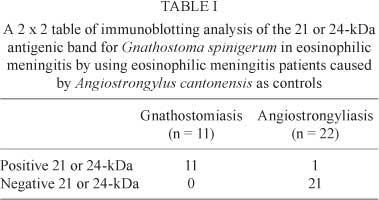Angiostrongylus cantonensis and Gnathostoma spinigerum are the two most common causative parasites of eosinophilic meningitis (EOM). Serological tests are helpful tools for confirming the identity of the pathogen. Recent reports determined the specificity of such tests by using normal healthy controls. There have been limited studies done to rule out the cross-reactivity between these two causative parasites of EOM. This study aims to assess the specificity of the serological test in EOM by using each condition as a control for the other. Thirty-three patients with a diagnosis of EOM were enrolled. Sera from 22 patients with a positive 29-kDa antigenic diagnostic band of A. cantonensis were tested for the 21 and 24-kDa antigenic bands of G. spinigerum. Similarly, sera of 11 gnathostomiasis patients were tested for the 29-kDa diagnostic band for A. cantonensis. Only one patient in the angiostrongyliasis group had a positive result for the 21 and 24-kDa antigenic bands of G. spinigerum, while no gnathostomiasis patients showed a positive result for the 29-kDa antigenic band of A. cantonensis. The specificity of the 21 and 24-kDa antigenic bands for gnathostomiasis and the 29-kDa antigenic band for A. cantonensis was 95.5% and 100%, respectively. The antigenic bands for the diagnosis of gnathostomiasis and angiostrongyliasis in EOM were highly specific.
specificity; eosinophilic meningitis; immunoblotting; Angiostrongylus cantonensis; Gnathostoma spinigerum


